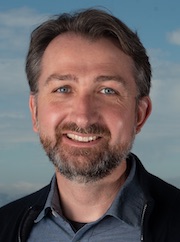by Lori Tamura

David Prendergast is an internationally recognized computational scientist whose first-principles calculations of x-ray spectra have helped with the interpretation of countless Advanced Light Source (ALS) experiments over the years. In light of this, the ALS Users’ Executive Committee (UEC) has awarded him the 2021 David A. Shirley Award for Outstanding Scientific Achievement at the ALS. He will also be delivering a keynote talk at the ALS User Meeting next month.
As a senior scientist at Berkeley Lab’s Molecular Foundry and director of its Theory of Nanostructured Materials facility, Prendergast is no stranger to cross-disciplinary collaboration at user facilities. “You’re often inspired by what users bring to you—very interesting problems that you might not have considered on your own,” said Prendergast. “I’m very grateful to that experience—what it taught me, and also what it has pushed me to do. It’s really rewarding and can drive a very successful career if you are open to all the novelty that comes from the user community.”

In his nomination letter, theoretical physicist John Rehr, professor emeritus at the University of Washington, noted that papers resulting from collaborations with experimental teams at the ALS demonstrate the power and importance of the theory and computational methods that Prendergast helped develop. “The centerpiece of the theory is the excited-core hole (XCH) approach, which is a major scientific accomplishment,” wrote Rehr. “Its treatment has become one of David’s most cited works.”
The approach is innovative for its efficiency due to a judicious choice of theoretical approximations. As a result, the method enables first-principles calculations for a broad range of materials, ranging from molecules and nanoscale systems to liquids and complex solids.
Eric Shirley, a physicist at NIST—and, coincidentally, the son of David Shirley, for whom the award is named—also wrote in support of the nomination. He observed that scientists use XCH to study systems that are chemically complicated and numerically challenging because of large system sizes (where large denotes the number of atoms necessary to include in a calculation). “In all this, the XCH technique treats systems with state-of-the-art accuracy,” wrote Shirley.
Prendergast is quick to credit Berkeley Lab’s supercomputing facility, NERSC, for helping enable the success of his approach. “Our trifecta of user facilities that we leverage to make this research happen—ALS soft x-ray spectroscopy, Molecular Foundry theory, and NERSC supercomputing—has really helped us tackle complex systems,” said Prendergast.
Over time, the method has been expanded to include finite-temperature and ultrafast techniques to treat a range of time, energy, length, and temperature scales. As a result, XCH has facilitated research in areas ranging from energy-storage materials and interfacial phenomena, to biomolecules and solvation phenomena.

One of Prendergast’s long-time collaborators is Richard Saykally, a professor of chemistry at UC Berkeley whose work at the ALS sought to develop more rigorous interpretations of the core-level spectra of aqueous systems. “This collaboration with David has engendered a significant advantage to my group as we pursued these subjects, because measured core-level spectra are difficult or even impossible to interpret without the availability of an appropriate theoretical calculation, and such calculations are extremely demanding,” wrote Saykally. “David has consistently and patiently provided the software and tutoring that has enabled my group to develop and publish state-of-the-art interpretations.”
A recent study on battery materials with Will Chueh, an associate professor of materials science and engineering at Stanford, is another example of Prendergast’s impact on ALS research. “We were trying to understand why the voltage of a popular battery cathode material tops out at a certain value,” said Prendergast. “We were seeing through Will’s measurements at the ALS that it was related to some structural rearrangements in the material, and where the lithium and the oxygen ions go. We could see that in the x-ray spectroscopy, but we definitely needed a theoretical model.”

With the help of Prendergast’s calculations, the researchers were able to rule out various hypothetical ion-migration mechanisms and confirm that the spectroscopic signatures of changes at the oxygen site are strongly affected by coordination number.
“Spectroscopy is a great tool,” said Prendergast. “It’s usually used as a fingerprint of materials, but sometimes it’s not clear from the fingerprint what is actually going on.”
When asked what it takes to be a successful computational scientist, Prendergast replied that there are two basic things. The first is to build a good foundation by learning the underlying theory and developing an appreciation for what it can do—what its strengths and weaknesses are.
The second thing is to have fun with it. “Experimentalists do experiments,” said Prendergast. “Nature provides the raw materials, and they mix things together in a certain way to get a certain outcome. Computationally, you can do something similar, almost like alchemy. You can put different pieces together in your simulation and just see what happens. And if you allow your curiosity to be piqued by the things that you observe and they look like they’re telling you something strange, maybe that’s worth hunting down to understand why.”
The Shirley Award is named after David Shirley, a professor of chemistry at UC Berkeley and director of Berkeley Lab from 1980 to 1989, whose vision was instrumental in building the ALS. Recipients of the award are selected by members of the ALS UEC, with input from ALS staff members representing the Recognition Task Force of the ALS Inclusion, Diversity, Equity, & Accountability (IDEA) Committee.
Each year, the Shirley Award recipient is invited to address a plenary session of the ALS User Meeting. This year, the Shirley Award talk is scheduled for Tuesday, August 10, at 9:55 a.m. PDT. Because the meeting will be held online, attendance is free and open to all who register.